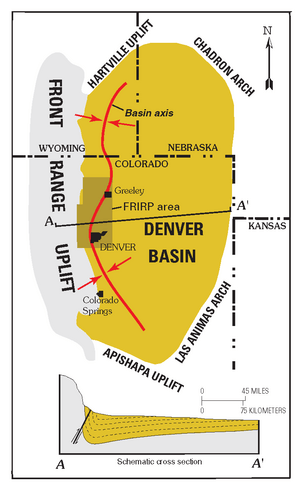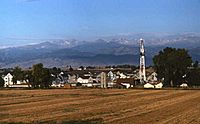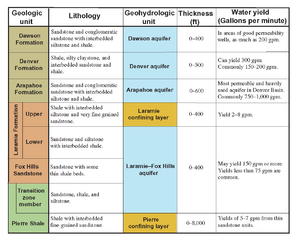Denver Basin facts for kids
The Denver Basin, also called the Julesburg Basin or D-J Basin, is a huge bowl-shaped area of rock layers. It's mostly in eastern Colorado, but also reaches into parts of Wyoming, Nebraska, and Kansas. This basin sits right under the Denver-Aurora Metropolitan Area on the eastern side of the Rocky Mountains.
Contents
How the Denver Basin Formed
The Denver Basin is like a giant, uneven bowl made of many layers of rock. These layers formed over millions of years, from ancient times (Paleozoic) through the age of dinosaurs (Mesozoic) and beyond (Cenozoic). The basin is deepest near Denver, reaching about 13,000 feet (3900 meters) below the surface.
Ancient Mountains and Seas
The basin started forming around 300 million years ago. This was during a time when the Ancestral Rockies mountains were created. Rocks from this period, like the Fountain Formation, can be seen today at places like Red Rocks Amphitheatre.
Later, the area was covered by a huge ancient ocean called the Cretaceous Interior Seaway. This sea deposited thick layers of rock, including sand and mud, which are now part of the basin.
The Modern Rocky Mountains
The basin likely got even deeper between 66 and 45 million years ago. This happened during the Laramide orogeny, which created the modern Rocky Mountains. As the Rockies pushed up, the land near Denver buckled downward, making the basin deeper. Over time, sediment (like sand and gravel) washed down from the rising Rockies and filled the basin.
Dinosaur Ridge
Near Denver, you can see some of these ancient rock layers sticking out of the ground. One famous spot is Dinosaur Ridge near Morrison, Colorado. Here, you can find real dinosaur footprints and dinosaur fossils! This area is now a special Colorado State Natural Area.
Natural Resources in the Basin
The Denver Basin holds many important natural resources deep within its rock layers.
Oil and Natural Gas
People have been finding oil and gas in the Denver Basin since 1901. Most of the oil and gas comes from sandstone layers that formed during the Cretaceous period.
Wattenberg Gas Field
One of the biggest natural gas areas in the United States is the Wattenberg Gas Field. It's just north of Denver. This field has produced a huge amount of natural gas and oil from many wells. In 2007, it was the 9th largest source of natural gas in the country!
Shallow Gas Fields
Some natural gas is also found closer to the surface, less than 3,000 feet deep. This gas is called "biogenic" gas. It's found in parts of northeastern Colorado and northwestern Kansas. Many wells are actively drilling for this gas today.
Coal
Coal has been mined in the Denver Basin for a long time. It comes from the Laramie Formation rock layer. Mining started in the late 1850s and continued until 1979 in some areas.
There are also large deposits of a softer type of coal called lignite. This lignite is found in the central part of the basin, east of Denver and Colorado Springs. Some mining happened between 1886 and 1940, but it was not a major operation.
Underground Water (Aquifers)
The upper rock layers of the Denver Basin act like giant sponges. They hold a lot of water underground. These underground water sources, called aquifers, are very important. They provide much of the water supply for the region. However, people are using more and more water, which raises concerns about having enough water for the future.
Building Materials
The basin also provides materials for building.
- Cement: Raw materials from the basin are used to make cement near Lyons, Colorado.
- Sand and Gravel: Sand and gravel are dug up for use in building projects.
- Dimension Stone: The Lyons Formation provides a type of stone called flagstone. This stone is used for patios and walkways.
Gold
Small amounts of gold have been found in the sands and gravels around Denver since the Pike's Peak Gold Rush in 1858. Even today, some sand and gravel pits still find gold when they wash their materials.
Uranium
A small amount of uranium ore has been mined from the Dakota Formation near Morrison, Colorado. While uranium is present, the Denver Basin has never been a major source of this element.






